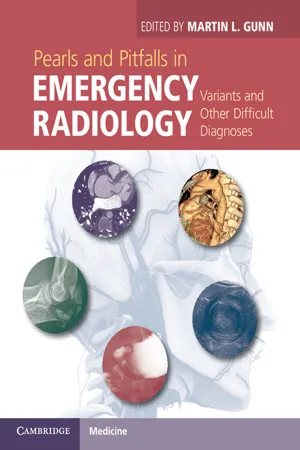
Pearls and Pitfalls in Emergency Radiology
Variants and Other Difficult Diagnoses
- English
- PDF
- Available on iOS & Android
About This Book
Rapid recognition of life-threatening illnesses and injuries expedites appropriate management and improves clinical outcomes. False-positive interpretations in radiology have been identified as a significant cause of error, leading to unnecessary investigation and treatment, increased healthcare costs, and delays in appropriate management. Moreover, it is important that radiologists do not miss important subtle diagnoses that need urgent intervention. Pearls and Pitfalls in Emergency Radiology provides an outline of common imaging artefacts, anatomic variants and critical diagnoses that the radiologist must master in order to guide appropriate care and avoid malpractice lawsuits. One hundred selected cases – illustrated with several hundred images from MRI, MDCT, PET, ultrasound and radiographs – are presented in a succinct and structured format, highlighting key pearls and potential diagnostic pitfalls. The text focuses on emergent presentations of diseases in all body regions in both adults and children.
Frequently asked questions
Information
Table of contents
- Contents
- Contributors
- Preface
- Acknowledgments
- Case 1 Isodense subdural hemorrhage
- Case 2 Non-aneurysmal perimesencephalic subarachnoid hemorrhage
- Case 3 Missed intracranial hemorrhage
- Case 4 Pseudo-subarachnoid hemorrhage
- Case 5 Arachnoid granulations
- Case 6 Ventricular enlargement
- Case 7 Blunt cerebrovascular injury
- Case 8 Internal carotid artery dissection presenting as subacute ischemic stroke
- Case 9 Mimics of dural venous sinus thrombosis
- Case 10 Pineal cyst
- Case 11 Enlarged perivascular space
- Case 12 Tumefactive multiple sclerosis
- Case 13 Cavernous malformation simulating contusion
- Case 14 Orbital infection
- Case 15 Diffuse axonal injury
- Case 16 Globe injuries
- Case 17 Dilated superior ophthalmic vein
- Case 18 Orbital fractures
- Case 19 Variants of the upper cervical spine
- Case 20 Atlantoaxial rotatory fixation versus head rotation
- Case 21 Cervical flexion and extension radiographs after blunt trauma
- Case 22 Pseudosubluxation of C2-C3
- Case 23 Calcific tendinitis of the longus colli
- Case 24 Motion artifact simulating spinal fracture
- Case 25 Pars interarticularis defects
- Case 26 Limbus vertebra
- Case 27 Transitional vertebrae
- Case 28 Subtle injuries in ankylotic spine disorders
- Case 29 Spinal dural arteriovenous fistula
- Case 30 Pseudopneumomediastinum
- Case 31 Traumatic pneumomediastinum without aerodigestive injury
- Case 32 Pseudopneumothorax
- Case 33 Subcutaneous emphysema and mimickers
- Case 34 Tracheal injury
- Case 35 Pulmonary contusion and laceration
- Case 36 Sternoclavicular dislocation
- Case 37 Boerhaave syndrome
- Case 38 Variants and hernias of the diaphragm simulating injury
- Case 39 Aortic pulsation artifact
- Case 40 Mediastinal widening due to non-hemorrhagic causes
- Case 41 Aortic injury with normal mediastinal width
- Case 42 Retrocrural periaortic hematoma
- Case 43 Mimicks of hemopericardium on FAST
- Case 44 Mimicks of acute thoracic aortic syndromes: aortic dissection, intramural hematoma, and penetrating aortic ulcer
- Case 45 Aortic intramural hematoma
- Case 46 Pitfalls in peripheral CT angiography
- Case 47 Breathing artifact simulating pulmonary embolism
- Case 48 Acute versus chronic pulmonary thromboembolism
- Case 49 Vascular embolization of foreign body
- Case 50 Simulated active bleeding
- Case 51 Pseudopneumoperitoneum
- Case 52 Intra-abdominal focal fat infarction: epiploic appendagitis and omental infarction
- Case 53 False-negative and False-positive FAST
- Case 54 Diaphragmatic slip simulating liver laceration
- Case 55 Gallbladder wall thickening due to non-biliary causes
- Case 56 Splenic clefts
- Case 57 Inhomogeneous splenic enhancement
- Case 58 Pseudosubcapsular splenic hematoma
- Case 59 Pseudopancreatitis following trauma
- Case 60 Pancreatic clefts
- Case 61 Pseudothickening of the bowel wall
- Case 62 Small bowel transient intussusception
- Case 63 Duodenal diverticulum
- Case 64 Pseudopneumatosis
- Case 65 Pneumatosis intestinalis
- Case 66 Pseudoappendicitis
- Case 67 Missed renal collecting system injury
- Case 68 Pseudohydronephrosis
- Case 69 Physiologic pelvic intraperitoneal fluid
- Case 70 Avoiding missed injuries to the bowel and mesentery: the importance of intraperitoneal fluid
- Case 71 Endometrial hypodensity simulating fluid
- Case 72 Pseudogestational sac
- Case 73 Cystic pelvic mass simulating the bladder
- Case 74 Ovarian torsion
- Case 75 Urine jets simulating a bladder mass
- Case 76 Extraluminal bladder Foley catheter
- Case 77 Missed bladder rupture
- Case 78 Pseudofracture from motion artifact
- Case 79 Mach effect
- Case 80 Foreign bodies not visible on radiographs
- Case 81 Accessory ossicles
- Case 82 Fat pad interpretation
- Case 83 Posterior shoulder dislocation
- Case 84 Easily missed fractures in thoracic trauma
- Case 85 Sesamoids and bipartite patella
- Case 86 Subtle knee fractures
- Case 87 Lateral condylar notch sign
- Case 88 Easily missed fractures of the foot and ankle
- Case 89 Thymus simulating mediastinal hematoma
- Case 90 Foreign body aspiration
- Case 91 Idiopathic ileocolic intussusception
- Case 92 Ligamentous laxity and intestinal malrotation in the infant
- Case 93 Hypertrophic pyloric stenosis and pylorospasm
- Case 94 Retropharyngeal pseudothickening
- Case 95 Cranial sutures simulating fractures
- Case 96 Systematic review of elbow injuries
- Case 97 Pelvic pseudofractures: normal physeal lines
- Case 98 Hip pain in children
- Case 99 Common pitfalls in pediatric fractures: ones not to miss
- Case 100 Non-accidental trauma: neuroimaging
- Case 101 Non-accidental trauma: skeletal injuries
- Index